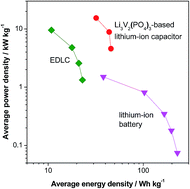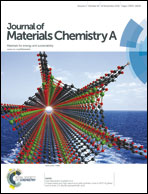Revisiting Li3V2(PO4)3 as an anode – an outstanding negative electrode for high power energy storage devices†
Abstract
Monoclinic Li3V2(PO4)3 (LVP) has long been considered primarily as a cathode material for lithium-ion batteries (LIBs). However, due to its amphoteric nature, LVP can also host additional lithium ions. Nonetheless, its use as an anode material for LIBs has hardly been investigated. In this work, we synthesize a nanostructured Li3V2(PO4)3 material with an ionic liquid-derived carbon coating and test it as an anode material for LIBs. The nanostructured LVP shows excellent rate capability and delivers an exceptionally high capacity of about 100 mA h g−1 at 100 C. Fast lithiation/delithiation of the material is enabled by its nanorod-like structure, which allows rapid Li+ diffusion, and its high electronic conductivity due to an effective carbon coating. Furthermore, when cycled at 50 C, the capacity retention is 91% after 10 000 cycles, and ex situ XRD shows a good preservation of the LVP structure. Due to its excellent high rate capacity and longterm stability, nanostructured LVP is a very promising candidate for the use as a negative electrode in lithium-ion capacitors (LICs). We show that a LIC containing LVP as a negative electrode and activated carbon as a positive one displays an energy density of 33 W h kg−1 at a power density of 16 kW kg−1; stable for 100 000 cycles.

- This article is part of the themed collection: 2014 Journal of Materials Chemistry A Hot Articles

 Please wait while we load your content...
Please wait while we load your content...